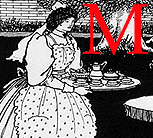 ost Victorian houses had stained glass fanlights above the front door and ceramic tiles around the porch. On a sunny day, or if there were a street lamp nearby, the wall inside was splashed with yellows, reds, blues, and greens. If the house had a vestibule, the inner door might also have stained glass panels or, at least, panes frosted into patterns, not unusually of flowers and urns.
ost Victorian houses had stained glass fanlights above the front door and ceramic tiles around the porch. On a sunny day, or if there were a street lamp nearby, the wall inside was splashed with yellows, reds, blues, and greens. If the house had a vestibule, the inner door might also have stained glass panels or, at least, panes frosted into patterns, not unusually of flowers and urns.


Two tiles by William de Morgan: Tudor Rose and Carnation.
Tiles tended to be more sombre: greens or browns, often bas-reliefs. The floor of the porch was usually tiled, too, in geometric patterns, while fireplaces were almost always surrounded by coloured and patterned tiles, below the mantel piece where the woman of the house kept her prized ceramic vases, or a clock.
As a child I found the fanlights a bit depressing because the world outside was so dark. It seemed wrong-headed to try to make things brighter in such small and pitiful ways. The medieval world favoured by Ruskin and William Morris was less colourful than ours, and we can barely imagine the impact of a cathedral's rose window on a man or woman who walked from a muddy village to town once or twice in lifetime. What did a bit of stained glass signify, I wondered, in a city whose walls were blackened by soot and smoke, especially in a part of the house where nobody lived, merely passed through? Status? A craving for colour in a dark world? Why not, I wanted to know, make the world outside more colourful? That was impossible, of course, at the time.
Few people now, perhaps, remember how smoke-blackened England's industrial towns once were. Lowrie's paintings of Manchester with its mill chimneys could have been one of dozens of northern towns. London, nicknamed The Smoke, was also a great industrial city in its own right. Even the rain, at times, was black, while smuts could fall from a clear sky if the wind were right. The great Victorian public buildings were unimaginably blackened. St Paul's, built of fine pale stone from quarries overlooking the sea on Portland Bill, was black as coal throughout Queen Victoria's reign.
When Victorian England wasn't horse drawn, it was coal fired and steam driven. Outside the front door of most houses was a man-hole opening into a coal cellar. The coalman carried, on one distorted shoulder, a hundredweight sack which he dropped, mouth down, directly over the coal hole with a single flick of the body.
Side streets were gas-lit, if lit is not too strong a word for the faint pools of light around each lamp post. At dusk a lamp lighter ran from post to post carrying a long pole with a flame and a hook on top; the hook opened the tap, the flame lit the jet. Pretty grim it was, too, on the cobblestones by a Victorian-built gasworks on a wet winter night in the choking smell of gas. Gasometers, where gas was stored, were great steel cylinders which rose and sank in and out of holes in the ground as they filled and emptied.
Many Victorian pubs, on the other hand, were bright and glittering and therefore perhaps all the more inviting. They were made brighter by big mirrors, etched with the names of ales or gin or whiskey, covering the walls so that reflected gaslight filled the place, although it too in turn was dimmed as the evening wore on by the tobacco smoke which stained the ceilings first yellow, then brown. A sharp smell of beer seeped into the street. So did noise: Victorian pubs were loud. People seemed to sing more readily back then (the whistling delivery boy or trades-man was commonplace) and many pubs had pianos (or joannas as they were just as commonly called).
They were little bubbles of light in a dark city. Dickens opens Bleak House with a long description of a London fog. Later generations would call it smog — a deadly mix of fog and smoke otherwise known as a London Particular or a pea-souper (it was a strange yellowy green colour and almost as opaque as pea soup). The deaths of over a thousand people in the last great smog led to the Clean Air Act of 1952, and the unintended end of blackened buildings. Most of the stained glass has gone as well, along with tiled porches and fireplaces.
Last modified 17 June 2006